|
|
 |
 |
|
© Unesco World Heritage Centre, Paris
According to the World Heritage Convention, "cultural
heritage" is a monument, group of buildings or site of
historical, aesthetic, archaeological, scientific, ethnological
or anthropological value.
"Natural heritage" designates outstanding physical,
biological, and geological features; habitats of threatened
plants or animal species and areas of value on scientific
or aesthetic grounds or from the point of view of conservation.
World Heritage monuments in Holland: |
Schokland
and Surroundings

|
Inscribed: 1995
Brief description:
Schokland was a peninsula that by the 15th century had become
an island. Occupied and then abandoned as the sea encroached,
it had to be evacuated in 1859. But following the draining
of the Zuider Zee, it has, since the 1940s, formed part of
the land reclaimed from the sea. Schokland has vestiges of
human habitation going back to prehistoric times. It symbolizes
the heroic, age-old struggle of the people of the Netherlands
against the encroachment of the waters. |
|
The Defence Line of Amsterdam

|
Inscribed: 1996
Brief description:
Extending 135 km around the city of Amsterdam, this defence
line (built between 1883 and 1920) is the only example of
a fortification based on the principle of controlling the
waters. Since the 16th century, the people of the Netherlands
have used their expert knowledge of hydraulic engineering
for defence purposes. The centre of the country was protected
by a network of 45 armed forts, acting in concert with temporary
flooding from polders and an intricate system of canals and
locks. |
|
The Mill Network at Kinderdijk-Elshout
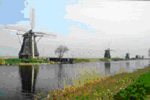
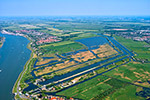
© Paul Paris Les Images

Click here for Google Maps
|
Inscribed:1997
Brief description:
The outstanding contribution made by the people of the Netherlands
to the technology of handling water is admirably demonstrated
by the installations in the Kinderdijk-Elshout area. Construction
of hydraulic works for the drainage of land for agriculture
and settlement began in the Middle Ages and has continued
uninterruptedly to the present day. The site illustrates all
the typical features associated with this technology –
dykes, reservoirs, pumping stations, administrative buildings
and a series of beautifully preserved windmills. |
|
Ir. D.F. Woudagemaal
(D.F. Wouda Steam Pumping Station)

|
Inscribed:1998
Justification for Inscription:
The advent of steam as a source of energy provided the Dutch
engineers with a powerful tool in their millennial task of
water management, and the Wouda installation is the largest
of its type ever built.
The Wouda Pumping Station represents the apogee of Dutch
hydraulic engineering, which has provided the models and set
the standards for the whole world for centuries.
The Wouda pumping installations bear exceptional witness
to the power of steam in controlling the forces of nature,
especially as applied to water handling by Dutch engineers.
Brief description:
The Wouda Pumping Station at Lemmer in the province of Friesland
opened in 1920. It is the largest steam-pumping station ever
built and is still in operation. It represents the high point
of the contribution made by Netherlands engineers and architects
in protecting their people and land against the natural forces
of water. |
|
Droogmakerij de Beemster
(The Beemster Polder)
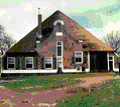
|
Inscribed: 1999
Justification for Inscription:
The Beemster Polder is a masterpiece of creative planning,
in which the ideals of antiquity and the Renaissance were
applied to the design of a reclaimed landscape.
The innovative and intellectually imaginative landscape of
the Beemster Polder had a profound and lasting impact on reclamation
projects in Europe and beyond.
The creation of the Beemster Polder marks a major step forward
in the interrelationship between humankind and water at a
crucial period of social and economic expansion.
Brief description:
The Beemster Polder, dating from the early 17th century, is
the oldest area of reclaimed land in the Netherlands. It has
preserved intact its well- ordered landscape of fields, roads,
canals, dykes and settlements, laid out in accordance with
classical and Renaissance planning principles. |
|
Rietveld Schröderhuis
(Rietveld Schröder House)

|
Inscribed:2000
Justification for Inscription:
The Rietveld Schröder House in Utrecht is an icon of
the Modern Movement in architecture, and an outstanding expression
of human creative genius in its purity of ideas and concepts
as developed by the De Stijl movement.
With its radical approach to design and the use of space,
the Rietveld Schröderhuis occupies a seminal position
in the development of architecture in the modern age.
Brief description:
The Rietveld Schröder House in Utrecht was commissioned
by Ms Truus Schröder-Schräder, designed by the architect
Gerrit Thomas Rietveld, and built in 1924. This small family
house, with its interior, the flexible spatial arrangement,
and the visual and formal qualities, was a manifesto of the
ideals of the De Stijl group of artists and architects in
the Netherlands in the 1920s, and has since been considered
one of the icons of the Modern Movement in architecture. |
|
Amsterdam’s 17th-century canal ring
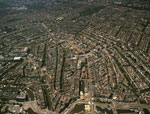
© Paul Paris Les Images
|
Inscribed:2010
Brief description:
Amsterdam’s 17th-century canal ring is an icon of urban planning and architecture and was built during the Golden Age It was a model of large-scale and long-term town planning that involved extending the city by draining the swampland, using a system of canals in concentric arcs and filling in the intermediate spaces with the area’s characteristic canal-side estates and numerous monuments This urban extension was the largest and most homogeneous of its time. and served as a reference throughout the world until the 19th century |
|
|
|
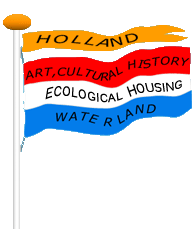
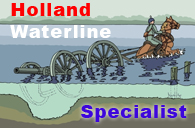
© illustration: Lex Tempelman

|



